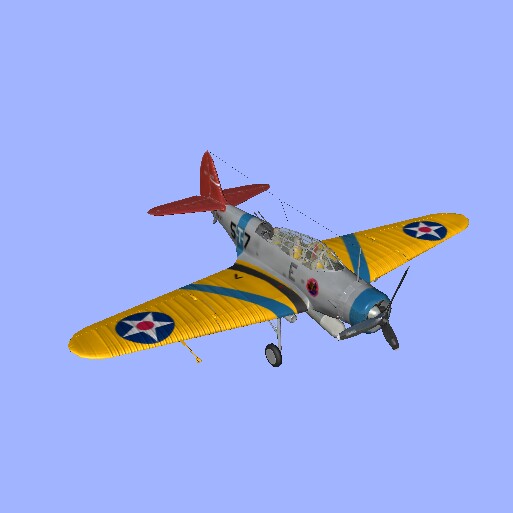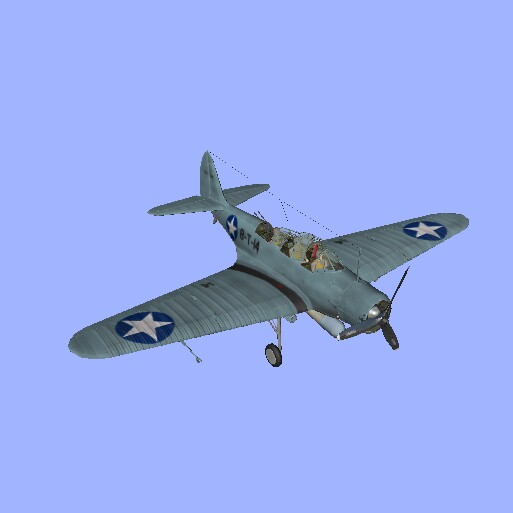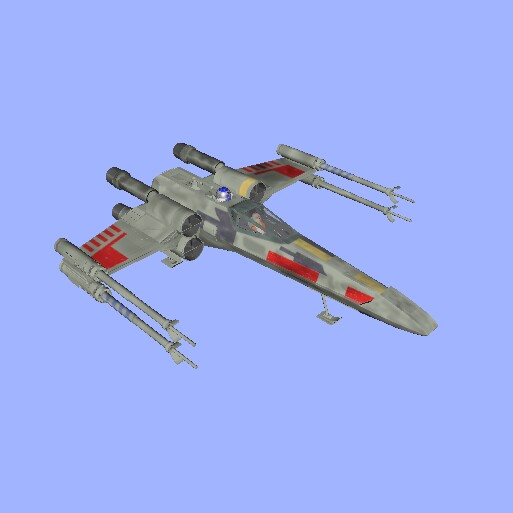Let's turn back the hands of time to 1915. Germany reigned supreme in the war-torn skies over Europe, and Great Britain was desperate for a way to counter the Fokker Eindecker aka "The Fokker Scourge." Sir Geoffrey de Havilland rose to the challenge, designing the D.H.2 as his second design for the Aircraft Manufacturing Company of The Hyde, London, England.
Here is my entry in George Miller's Designer's Contest, the Airco D.H.2. I have modeled tail #6011 as flown by Canadian ace Captain Arthur Gerald Knight. He scored the first of his 8 kills in this bird on 22 June 1916 near Courcelette, France. His remaining 7 kills were scored in several other D.H.2's before he died as the 13th victim of Manfred von Richthofen.
I have attempted to add several unique features to this model:
1) ALL the control cables are animated. You will have to look close to see some move, not so close for others. But ALL move as they should. Watch the elevator cables in particular, there are 4 cables in all routed through the upper 2 pulleys mounted on the wing struts.
2) Like most planes of this era, the D.H.2 had a rotary engine - the entire engine spins with the propeller. I have modeled this by adding a fully-modeled and animated Gnome Monosoupape engine, and also modeled the throttle of a rotary engine which is either at 0%, or 100% - no in-between.
3) That big 4-bladed prop looked great on the model but something was missing. So I added a 3D brass propeller boss with 8 hex-nuts to hold the propeller on the crankcase. Look close, both front and back are modeled. If anyone wants a different prop this will cause problems unless you scale the prop visually to fit the boss. Sorry about that!
Keep the throttle in mind when you fly this bird. It is "all or none" and that will require some adaptation on your part. Throttle of course is worked by the throttle stick, but the engine will not run until you reach 50% stick travel. Once you hit 50%, the engine is at full throttle for the rest of the stick travel. So, for taxiing, final approach, etc you will have to "blip" the throttle to reach and maintain desired speed. This is how it was done in the early days, and I've done my best to simulate it. It takes some getting used to but it is a lot of fun.
Another thing to note, is this is a "hybrid" engine It is electric, with a gas sound. Electric was necessary so you can stop the engine in the editor and look at the engine details. The gas sound was necessary also, this bird needs it! Try taxiing over to your feet, turn the tail toward you and cut the throttle - it's pretty cool watching the blades and rotary engine spin down and hear the cylinders popping as the engine slows to a stop!
It is electric, with a gas sound. Electric was necessary so you can stop the engine in the editor and look at the engine details. The gas sound was necessary also, this bird needs it! Try taxiing over to your feet, turn the tail toward you and cut the throttle - it's pretty cool watching the blades and rotary engine spin down and hear the cylinders popping as the engine slows to a stop!
Controls are simple - aileron, elevator, rudder, throttle. Dual-rates on the upper-left toggle, toggle toward you for low rates, away for high rates.
Hope you enjoy it!
Visual Model - DirtyHarry3033
Physics Model- DirtyHarry3033
CS - DirtyHarry3033
Here is my entry in George Miller's Designer's Contest, the Airco D.H.2. I have modeled tail #6011 as flown by Canadian ace Captain Arthur Gerald Knight. He scored the first of his 8 kills in this bird on 22 June 1916 near Courcelette, France. His remaining 7 kills were scored in several other D.H.2's before he died as the 13th victim of Manfred von Richthofen.
I have attempted to add several unique features to this model:
1) ALL the control cables are animated. You will have to look close to see some move, not so close for others. But ALL move as they should. Watch the elevator cables in particular, there are 4 cables in all routed through the upper 2 pulleys mounted on the wing struts.
2) Like most planes of this era, the D.H.2 had a rotary engine - the entire engine spins with the propeller. I have modeled this by adding a fully-modeled and animated Gnome Monosoupape engine, and also modeled the throttle of a rotary engine which is either at 0%, or 100% - no in-between.
3) That big 4-bladed prop looked great on the model but something was missing. So I added a 3D brass propeller boss with 8 hex-nuts to hold the propeller on the crankcase. Look close, both front and back are modeled. If anyone wants a different prop this will cause problems unless you scale the prop visually to fit the boss. Sorry about that!
Keep the throttle in mind when you fly this bird. It is "all or none" and that will require some adaptation on your part. Throttle of course is worked by the throttle stick, but the engine will not run until you reach 50% stick travel. Once you hit 50%, the engine is at full throttle for the rest of the stick travel. So, for taxiing, final approach, etc you will have to "blip" the throttle to reach and maintain desired speed. This is how it was done in the early days, and I've done my best to simulate it. It takes some getting used to but it is a lot of fun.
Another thing to note, is this is a "hybrid" engine
Controls are simple - aileron, elevator, rudder, throttle. Dual-rates on the upper-left toggle, toggle toward you for low rates, away for high rates.
Hope you enjoy it!
Visual Model - DirtyHarry3033
Physics Model- DirtyHarry3033
CS - DirtyHarry3033






